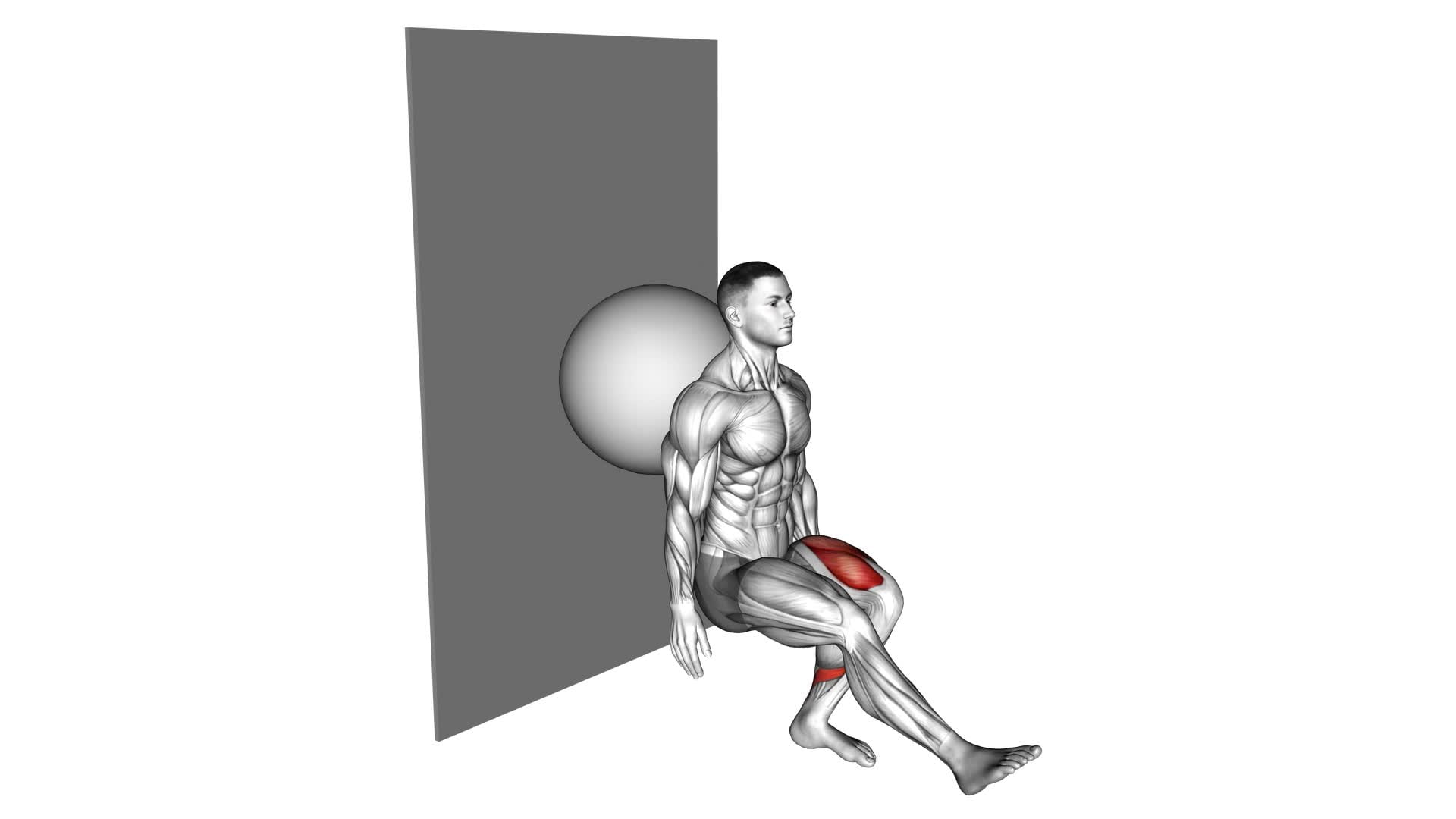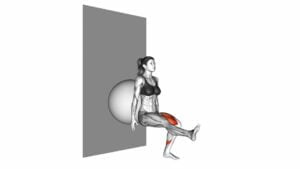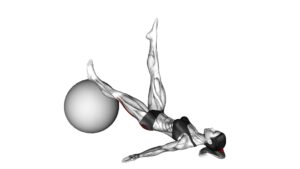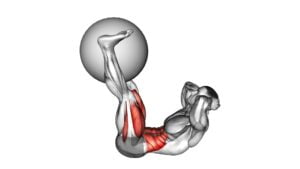Stability Ball Single Leg Squat (male) – Video Exercise Guide & Tips

Get ready to strengthen your lower body with the Stability Ball Single Leg Squat! This exercise is perfect for males looking to challenge their balance, stability, and leg muscles.
Watch This Exercise Video
In this video exercise guide, you'll learn the proper form and technique, as well as modifications for beginners and tips for advancing your progress.
Avoid common mistakes and ensure your safety with the included precautions.
Let's dive in and level up your fitness game!
Key Takeaways
- Stability Ball Single Leg Squat improves balance and stability.
- Proper form and technique are important for targeting specific leg muscles and avoiding injuries.
- Hip and knee alignment should be maintained to target the correct muscles and prevent injuries.
- Engaging the core for stability and balance is crucial during the exercise.
Benefits of Stability Ball Single Leg Squat
You can improve balance and strengthen your lower body by performing the Stability Ball Single Leg Squat. This exercise is great for improving lower body strength, increasing stability, and enhancing overall balance.
To begin, place a stability ball against a wall and stand in front of it with your feet hip-width apart. Lift one leg off the ground and extend it in front of you, keeping your foot flexed. Place the other foot firmly on top of the stability ball, ensuring that your weight is evenly distributed.
Engage your core and slowly lower your body into a squat position by bending your standing leg. Make sure to keep your knee aligned with your toes and your chest lifted throughout the movement. Aim to lower yourself until your thigh is parallel to the ground, or as close as you can comfortably go.
Push through your heel to rise back up to the starting position, maintaining control and balance. Repeat the movement for the desired number of repetitions before switching legs.
Proper Form and Technique
To perform the Stability Ball Single Leg Squat with proper form and technique, there are a few key points to keep in mind.
First, focus on maintaining proper alignment of your hip and knee throughout the movement. This will help prevent any unnecessary strain on your joints.
Second, engage your core to maintain stability and balance as you perform the exercise. This will help you stay in control and get the most out of each repetition.
Hip and Knee Alignment
Maintain proper alignment of your hips and knees during the Stability Ball Single Leg Squat exercise to optimize form and technique. Proper alignment is crucial for preventing injuries and maximizing the effectiveness of the exercise.
When your hips and knees are aligned, you ensure that the correct muscles are being targeted and engaged.
One common mistake is letting your knees collapse inward. This puts unnecessary stress on your knee joints and can lead to instability and discomfort.
Another mistake is allowing your hips to shift to one side. This imbalance can result in poor form and reduced effectiveness of the exercise.
To maintain proper alignment, focus on keeping your knees in line with your toes and your hips centered over the stability ball.
Core Stability and Balance
To optimize your form and technique for the Stability Ball Single Leg Squat exercise, it's important to focus on maintaining core stability and balance.
Core stability refers to the ability of your core muscles to support and stabilize your spine during movement. This exercise challenges your core stability by requiring you to balance on one leg while performing the squat.
To improve your core stability and balance, engage your core muscles by drawing your belly button towards your spine and maintaining a neutral spine throughout the exercise. Keep your chest lifted and your shoulders back and down.
Modifications for Beginners
If you're new to stability ball single leg squats, a helpful modification is to perform the exercise with both feet on the ground. This modification is perfect for beginners who are still working on their balance and stability. By keeping both feet on the ground, you can focus on mastering the proper form and alignment before progressing to the single leg version.
To perform the modified stability ball squat, start by standing with your feet shoulder-width apart and place the stability ball against a wall behind you. Lean back and lower yourself into a squat position, making sure to keep your knees aligned with your toes and your weight in your heels. As you lower down, imagine sitting back into a chair.
Once you have reached a comfortable squat position, push through your heels to stand back up. Remember to engage your core and keep your chest lifted throughout the movement. Repeat for the desired number of repetitions.
As you become more comfortable with the modified version, you can gradually progress to the single leg squat by lifting one foot off the ground and balancing on the stability ball. This will further challenge your stability and strength. But for now, focus on mastering the basics and gradually progress at your own pace.
Tips for Advanced Progression
Once you have mastered the stability ball single leg squat with both feet on the ground, you can enhance your workout by progressing to the advanced version. By incorporating advanced variations, you'll challenge your balance, strength, and stability even further, increasing the difficulty of the exercise.
One way to advance the stability ball single leg squat is by performing it with one foot elevated. Place one foot on a sturdy platform, such as a step or a bench, while keeping the other foot on the stability ball. This variation requires greater stability in the standing leg and engages more muscles in your lower body.
Another advanced variation is the stability ball single leg squat with a weight. Hold a dumbbell or a kettlebell in one hand while performing the exercise. This added resistance increases the demand on your muscles, making the exercise more challenging and effective for building strength.
To further increase the difficulty, you can try the stability ball single leg squat with an overhead press. Hold a dumbbell or a kettlebell in each hand and extend your arms overhead as you squat. This variation not only engages your lower body but also works your shoulders, arms, and core.
Remember to always maintain proper form and control throughout these advanced variations. Start with lighter weights and gradually increase as you become more comfortable and confident with the exercise. Incorporating these variations into your workout routine will help you continue to progress and achieve your fitness goals.
Common Mistakes to Avoid
As you progress to the advanced variations of the stability ball single leg squat, it's important to be aware of common mistakes to avoid. Proper alignment is key to performing this exercise correctly and maximizing its benefits. Here are four common mistakes to watch out for:
- Leaning too far forward: One of the most common mistakes is leaning too far forward during the squat. This can put excessive strain on your lower back and may cause injury. Focus on keeping your torso upright and your weight centered over your standing leg.
- Allowing your knee to collapse inward: Another mistake is allowing your knee to collapse inward as you lower into the squat. This can put stress on your knee joint and increase the risk of injury. Make sure to keep your knee in line with your toes throughout the movement.
- Not engaging your core: Neglecting to engage your core can lead to poor stability and control during the exercise. Remember to tighten your abdominal muscles and maintain a stable core throughout the squat.
- Using momentum instead of control: Lastly, using momentum instead of control can diminish the effectiveness of the exercise. Focus on a slow and controlled movement, lowering yourself down and then pushing through your heel to return to the starting position.
By avoiding these common mistakes and maintaining proper alignment, you can perform the stability ball single leg squat safely and effectively.
Now, let's move on to the next section about safety precautions and considerations.
Safety Precautions and Considerations
To ensure a safe and effective workout, it's important to keep in mind several safety precautions and considerations when performing the stability ball single leg squat.
First and foremost, make sure you have the appropriate safety equipment. Using a stability ball that's the correct size and properly inflated is crucial to maintaining stability and preventing injury. Additionally, wearing comfortable and supportive athletic shoes will provide stability and protect your feet during the exercise.
Before starting the stability ball single leg squat, it's essential to warm up your body. Engaging in warm-up exercises such as dynamic stretches and light cardio activities will increase blood flow to the muscles, improve flexibility, and reduce the risk of injury. Spend a few minutes performing exercises like leg swings, walking lunges, or jumping jacks to prepare your body for the workout.
When performing the stability ball single leg squat, it's important to maintain proper form and technique. Keep your back straight, shoulders relaxed, and core engaged throughout the exercise. As you lower yourself into the squat position, ensure that your knee stays aligned with your toes to prevent any strain or injury to the knee joint. Take it slow and controlled, focusing on maintaining balance and stability on the stability ball.
Frequently Asked Questions
How Many Reps and Sets Should Be Done for the Stability Ball Single Leg Squat Exercise?
To get the most out of the stability ball single leg squat exercise, it's important to know how many reps and sets to do.
By performing 3 sets of 10-12 reps, you'll challenge your leg muscles and improve your balance and stability.
This exercise is great for targeting the quads, glutes, and core muscles.
Remember to maintain proper form and control throughout the movement for maximum benefits.
What Muscles Does the Stability Ball Single Leg Squat Primarily Target?
The stability ball single leg squat primarily targets your quads, hamstrings, and glutes. This exercise is a great way to work on your lower body strength and stability.
By performing variations of the stability ball single leg squat, you can challenge different muscle groups and improve your balance and coordination.
The benefits of incorporating this exercise into your routine include increased lower body strength, improved core stability, and enhanced overall athletic performance.
Can the Stability Ball Single Leg Squat Be Performed Without a Stability Ball?
If you don't have a stability ball, there are alternative exercises you can try to target similar muscles as the stability ball single leg squat.
One modification is to perform a single leg squat on the ground or using a bench for support. This will still work your leg muscles and challenge your balance.
Remember to keep proper form and engage your core throughout the exercise.
How Can I Increase the Difficulty of the Stability Ball Single Leg Squat Exercise?
To increase the difficulty of the stability ball single leg squat exercise, there are a few things you can try.
First, you can add weight by holding dumbbells or using a weighted vest.
Another option is to increase the range of motion by squatting lower or elevating your foot on a step.
Lastly, you can try performing the exercise on an unstable surface like a balance board.
Remember to focus on proper form and avoid common mistakes like leaning forward or allowing your knee to collapse inward.
Are There Any Alternatives or Variations to the Stability Ball Single Leg Squat Exercise That I Can Try?
Looking for alternatives or modifications to the stability ball single leg squat exercise?
There are a few options you can try.
One alternative is the pistol squat, which involves balancing on one leg while lowering your body down into a deep squat.
Another option is the Bulgarian split squat, where you place one foot on a raised surface behind you and lower your body down into a lunge position.
These variations can provide a similar challenge to the stability ball single leg squat.
Conclusion
To sum up, the stability ball single leg squat is a challenging exercise that offers numerous benefits for strength and stability.
By maintaining proper form and technique, beginners can gradually progress and modify the exercise to suit their fitness level.
Advanced individuals can further challenge themselves with additional tips for progression.
However, it's important to avoid common mistakes and prioritize safety precautions while performing this exercise.
With practice and consistency, this exercise can greatly improve lower body strength and balance.

Author
Years ago, the spark of my life’s passion ignited in my mind the moment I stepped into the local gym for the first time. The inaugural bead of perspiration, the initial endeavor, the very first surge of endorphins, and a sense of pride that washed over me post-workout marked the beginning of my deep-seated interest in strength sports, fitness, and sports nutrition. This very curiosity blossomed rapidly into a profound fascination, propelling me to earn a Master’s degree in Physical Education from the Academy of Physical Education in Krakow, followed by a Sports Manager diploma from the Jagiellonian University. My journey of growth led me to gain more specialized qualifications, such as being a certified personal trainer with a focus on sports dietetics, a lifeguard, and an instructor for wellness and corrective gymnastics. Theoretical knowledge paired seamlessly with practical experience, reinforcing my belief that the transformation of individuals under my guidance was also a reflection of my personal growth. This belief holds true even today. Each day, I strive to push the boundaries and explore new realms. These realms gently elevate me to greater heights. The unique combination of passion for my field and the continuous quest for growth fuels my drive to break new ground.







